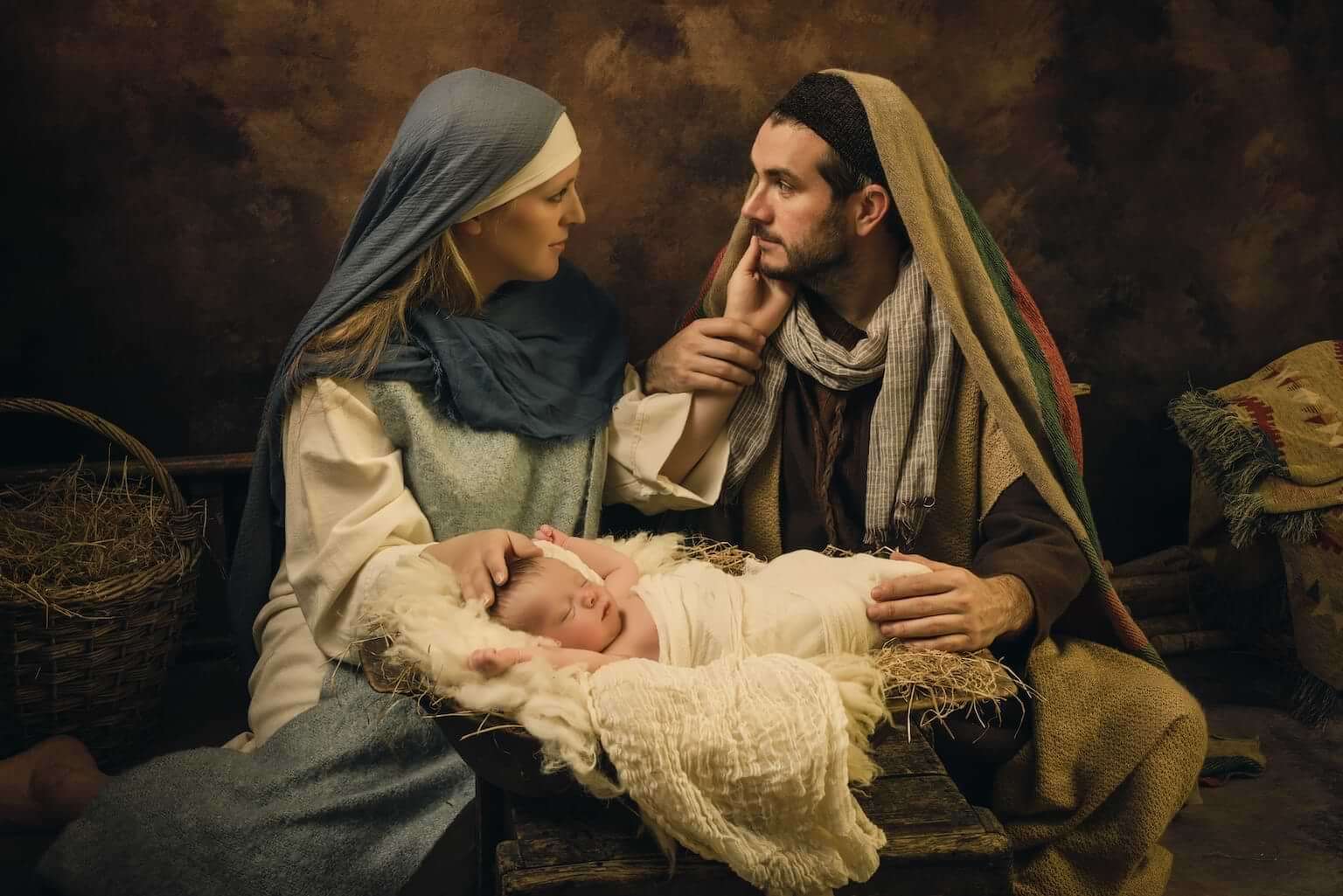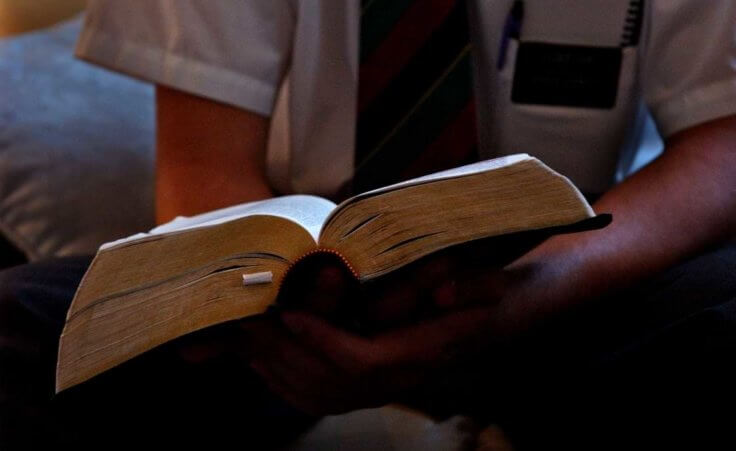
Mary looks at Joseph as they sit behind the baby Jesus in a manger in a live nativity scene. By Anneke/stock.adobe.com
While it’s not unusual for nativity scenes to make the news around Christmastime, a different form of public display inside the Iowa state capitol building has made headlines in recent days. The Satanic Temple placed a statue of the pagan idol Baphomet and other satanic paraphernalia in the building’s rotunda near the capitol’s annual nativity scene.
While the scene has generated quite a bit of controversy from many of the state’s citizens, responses from the community have varied.
Governor Kim Reynolds called it “absolutely objectionable” while asking for prayer over the building. Rep. Jon Dunwell pointed out, “I don’t want the state evaluating and making determinations about religions.” Considering history has shown that when the government attempts to regulate religion, religion usually loses, he has a point.
Conversely, Michael Cassidy—who ran an unsuccessful campaign for Congress in Mississippi last year—responded by tearing the idol down yesterday. He’s since been charged with fourth-degree criminal mischief.
What has largely gotten lost in the controversy, however, is that equal representation for satanic groups isn’t really the point they’re trying to make by placing their idol on capitol grounds.
As Russell Moore described, “These gaudy goats exist to make a point in the culture war—namely, that public places shouldn’t allow Christmas crèches or Hanukkah menorahs and so forth. The devil displays are just a means to an end. It’s not so much about whom the followers love as about whom they hate, which is religious people—especially the kind that would be outraged by a devil in the capitol.”
As he goes on to conclude, “Shock and repulsion from religious people aren’t merely unintentional byproducts; they’re the whole point.”
Consequently, when Christians like Cassidy react to such displays with anger and violence rather than prayer or dialogue, we play right into the hands of those who are hoping for just such a response.
Fortunately, there is positive news when it comes to Christmas displays that honor God as well.
Why are nativity displays still popular in post-Christian England?
While nativity displays are common throughout many regions of America, it may surprise you to learn that public displays of Christ’s birth play an equally—if not more—significant role across the Atlantic.
In England, roughly 25 percent of parents of kids under the age of eighteen go to church with any semblance of consistency. Yet, as Madeleine Davies describes, 78 percent of the population support their children’s schools putting on nativity plays every Christmas. Considering that 94 percent of all kids in the UK go to state-funded schools, the gap between those who look forward to attending a nativity play and those who would go to church to hear a sermon on the same subject is quite vast.
For most, the reason has less to do with religion than it does nostalgia. As Rob Barward-Symmons, the impact and evaluation manager at the Bible Society, notes, these plays function as “a valued rite of passage for parents to share with their children.” A Hindu mother who attended a Church of England school as a child added that she wants her children to “have the same memories” and to know the same story that she “learned as a kid.”
And even if the story of Christ’s birth will remain just a story for many of these children, we should not underestimate the power of nostalgia and what God can do with even those small seeds later in life.
In a way, connecting people personally with the Christmas story has been the purpose of such plays since the Middle Ages. And the similarities between their purpose then and now extend in some interesting and noteworthy ways.
Nativity scenes tell the story that many won’t read
Tradition holds that Saint Francis of Assisi set up the first live nativity scene in 1223 as a backdrop for his Christmas Eve sermon. Within a century, they’d grown in popularity and began to be featured at churches throughout Europe.
As Eleanor Parker, a lecturer in medieval English literature at Oxford, describes, the plays eventually evolved into standalone productions that told the entire story of the Bible from creation to Revelation. Such performances served an important purpose within medieval society because back then both the Bible and the sermons at Mass were in Latin at a time when few outside the clergy could understand that language. As a result, paintings, sculptures, and plays were often the only way they could learn the biblical stories.
In a similar way, our culture is increasingly illiterate when it comes to the Bible. Few outside the church—and, unfortunately, far too few inside the church as well—are likely to pick up a Bible and read it for themselves. As such, nativity plays and other traditions like Christmas carols can serve an important role in translating the truth of God’s word in a way that often slips past the barriers that people raise against the faith at other times of the year.
The question for us then becomes whether we will position ourselves to take advantage of those opportunities when they arise.
This Christmas, give the gift of faith
While I haven’t seen it as much this year as in the past, the notion that the culture is waging a war on Christmas remains far too common a refrain among many in the church. That’s not to say the accusations do not, at times, have some merit. However, seeing aspects of Christmas appropriated in ways that leave much of the message behind still presents us with unique opportunities to share the gospel with those who desperately need to hear it.
For many, Christmas carols, nativity scenes, and other Christian traditions carry a degree of nostalgia and fondness for reasons that have little to do with celebrating the birth of our Lord. But that doesn’t mean the path to turning those traditions back to Christ isn’t much shorter now than at other times of the year.
If you hear a neighbor or coworker remark that they love a particular carol, take a second to ask them what they like about it. If you see a nativity scene or Christian decoration in their yard or office, ask what it means to them. These simple questions can present the chance to have truly meaningful conversations, and the same can be true with family and friends as well.
After all, given that a large percentage of kids who grow up in at least nominally Christian homes leave the faith later in life, many devout followers of Jesus have family members who do not share that faith. Yet even among those who have rejected Christ, Christmas often holds fond memories, and family traditions rooted in the gospel can persist even after interest in the gospel has waned.
So as December 25 draws closer, let’s look for opportunities to celebrate and redeem the culture’s approach to Christmas. Their approach to the holiday may not always mirror our own, but that doesn’t mean God can’t still use it in some truly remarkable ways. The question for us is whether we will be ready to help when those opportunities arise.
Will you?













